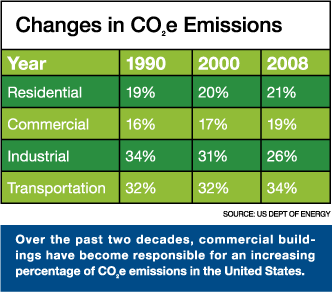Focus on Buildings to Cut Your Carbon Footprint
The biggest impact on carbon emissions can be achieved by directing your attention to buildings. According to the Department of Energy, buildings use 39 percent of the energy and 74 percent of the electricity produced each year in the United States.
A University of Michigan study showed that 91 percent of a building's emissions come from its use and 9 percent from its construction. So far the focus on the building sector has only come from the emissions caused by the "use" of a building, but that's only one portion of the total carbon emissions. There is also a carbon impact from the manufacture and transport of building products. So it's important that a building product that can already have a large carbon footprint save a great deal of energy during the "use" phase of the building.
The Leadership in Energy and Environmental Design (LEED) rating system outlines ways to reduce environmental effects from buildings. By choosing the right materials to start, a building can benefit throughout its complete life cycle.
Retrofitting can also help. The owners of the Empire State Building, for example, spent $13 million on windows, insulation and other upgrades to cut energy use by 38 percent and save about $4.4 million a year. That equaled a three-year payback.
According to McGraw Hill's "Green Outlook 2011: Green Trends Driving Growth," green building processes reduce operating costs by 9 to 14 percent; increase building value 7 to 11 percent; increase occupancy by 3 to 6 percent; and increase rents by 1 to 6 percent. Also, Jones Lang LaSalle and CoreNet's annual Sustainability Survey found 50 percent of respondents would pay more for green leased space. Further, 48 percent of respondents said they would pay up to a 10 percent premium for green space and 2 percent said they would pay more than 10 percent. Rating systems like LEED or the Green Building Initiative's Green Globes system are great places to start.
Scoping Out the Emissions Calculations
The most basic way to start looking at energy use is to establish a baseline and measure your Scope 1 and Scope 2 carbon footprint. Next, conduct a thorough energy audit of the building. By identifying where your energy use is coming from and where you are wasting energy, you can determine the best return on investment. The 2006 Building Data Book from the Department of Energy identifies both CO2e use and energy use. It is clear that attacking one affects both, but keep in mind that this data can vary greatly from state to state because of differences in power generation.
The best return on investment comes from looking at areas that use the most energy with the least cost. For example, lighting can have a large effect. If you change from T-12 to T-5 lighting or even LEDs, the electricity savings often have a less than two-year payback. Of course, this all depends on how the buildings are used. That's why an individual audit is so important.
Space heating and cooling combined make up about 25 percent of the average commercial building's energy use and 19 percent of the carbon emissions. So looking at the building envelope and HVAC system has the potential to produce significant returns.
Depending on location, the use of solar thermal collectors combined with radiant heat can have a very quick payback. In certain states solar photovoltaic and wind power can have a six to 10 year payback.
As always, it's important to do your research and measure twice: once to determine your carbon footprint and once to find the greatest energy efficiencies.
Eric Taub is the co-founder and managing partner of Verus Carbon Neutral. Verus is an Atlanta-based environmental consultancy focusing on helping businesses create value and reduce greenhouse gas emissions.
Related Topics:













